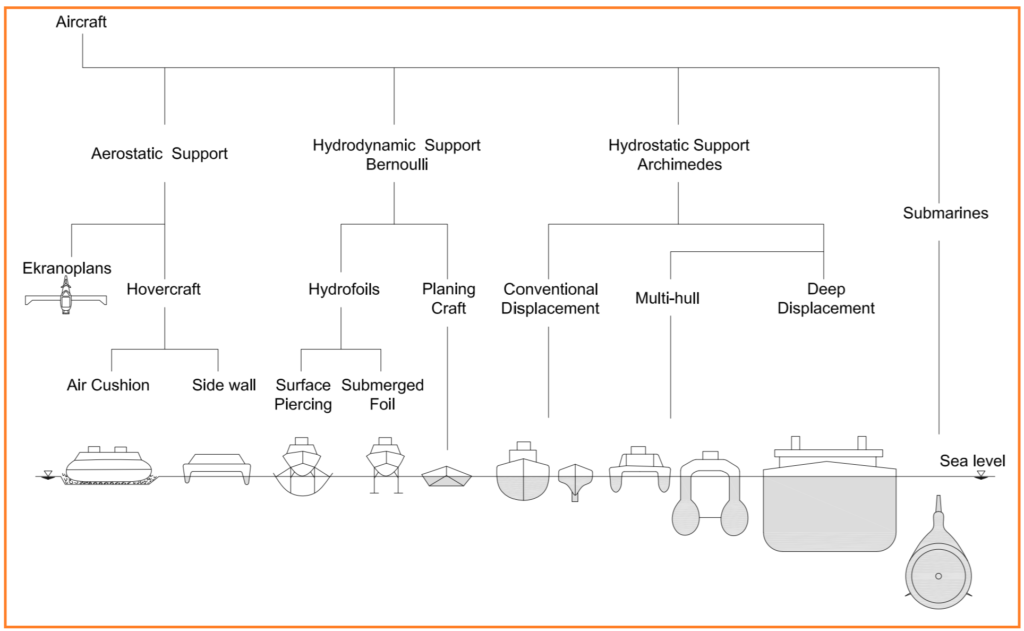Following is an overview of various ship types. Let’s summarize the main categories mentioned:
- Mission and Service Category: Ships can be categorized based on their primary purpose or mission, such as commercial (cargo vessels for trade), defense (naval ships), leisure and tourism (passenger ships), or special purpose (e.g., icebreakers, pleasure yachts, leisure boats).
- Applied Technologies Category: Ships can also be categorized based on the technologies applied in their design and construction. This can include subcategories such as hydrodynamic capability and material type. For example, innovative High-Speed Crafts (HSC) would fall under this category, as they rely on advanced hydrodynamic principles and lightweight hull materials like aluminum, composites, or carbon fiber.
These ship types help in understanding the diverse nature of ships and their specific characteristics, which can vary widely depending on their intended use and technological features.

Applied Technologies Ship Types
Here is additional detail on the applied technologies types for ship categorization. Here’s a summary:
- Hydrodynamic Capability and Material Type: This subcategory focuses on the hydrodynamic characteristics of ships and the materials used in their construction. Innovative High-Speed Crafts (HSC) are highlighted here, which require advanced hydrodynamic design to optimize performance. Additionally, lightweight hull materials like aluminum, composites, and carbon fiber are used to reduce weight and improve efficiency.
- Cargo Handling and Storage: Different types of ships employ various cargo handling and storage systems tailored to their specific cargo requirements. For example, LNG/LPG and tanker ships utilize piping systems for liquid cargo transfer, while container ships and bulk carriers use vertical lifting equipment such as pallets and cranes. Roll-on/Roll-off (Ro-Ro) ships facilitate cargo loading and unloading by rolling it onto and off the ship.
- Propulsion Capability: This subcategory involves the propulsion systems used in ships. LNG and passenger ships may utilize single or twin-screw propellers, while HSC commonly use high-performance waterjets for propulsion. Emerging technologies like sails or Flettner rotors are also mentioned as potential options for energy-efficient propulsion in ocean-going ships or small boats.
- Power Generation Methods: The future of power generation in ships is expected to evolve, driven by sustainability requirements. Emerging methods such as batteries, hydrogen fuel cells, and other alternative fuels are anticipated to become more prevalent in the maritime industry to reduce emissions and increase sustainability.
These ship types provide a detailed insight into the technological aspects that influence the design, operation, and efficiency of various types of ships.
Ship types characteristics
Certainly! Here’s the information organized into a table format:
| Ship Type | Advantages | Limitations |
|---|---|---|
| Monohulls | – Many empirical design data available. – Low building cost per unit displacement. – Small relative wetted area. | – Speed in heavy weather is limited by roll and pitch motions, slamming, green seas, and longitudinal bending moments. |
| Catamarans | – Low building cost per unit displacement. – High altitude cruising in waves, leading to low wave resistance. – Low probability of slamming. – Wide overall beam. | – High metal weight per unit displacement. – Speed limited by pitch motion, wet deck slamming, and longitudinal bending moments. |
| Trimarans | – Wide cargo deck well above waterline. – Satisfactory initial transverse stability. – Lower wave resistance than mono-hulls. – Low probability of bottom slamming. | – Large wetted deck area. – High longitudinal bending moment, especially in high seas. – Maneuvering and directional control problems. |
Ship Types based on their area of operations:
Ships can be categorized based on where they operate. Some ships are designed for global operations, while others are meant for specific regions like the Canadian Great Lakes, Baltic or South China Seas, or ice-infested areas like the Arctic and Southern Ocean. Coastal ships operate along coastlines, while inland waterway vessels navigate rivers and canals.
Another way to classify ships is by their design constraints. Weight-limited ships, such as bulk carriers and timber cargo ships, are designed to carry heavy cargo. Space-limited ships, like cruise liners and RoPax ships, prioritize passenger transport and may also carry light cargo. Size-limited ships are affected by infrastructure limitations in certain areas, such as draft and beam constraints in canals and ports.
Lastly, ships can be categorized by their hull types. Mono-hull vessels, like traditional bulk carriers and tankers, have a single hull structure. Multi-hull vessels, on the other hand, have innovative designs like Small Water Plane Area Twin Hull (SWATH) ships, which offer stability in rough weather, Wave Piercing Catamarans (WPC) for high-speed coastal service, and trimaran warships. Some designs even feature pentamaran configurations for efficient transatlantic service.
Advantages and limitations of Small Waterplane Area Twin Hull ships (SWATH)
Here’s a table outlining the advantages and limitations of Small Waterplane Area Twin Hull (SWATH) ships:
| Advantages | Limitations |
|---|---|
| Wide and well-elevated deck area with excellent initial stability, roll, and pitch motions | Wide overall beam. |
| Wide overall beam | Low additional resistance in waves |
| Low longitudinal bending moment which drops at higher speed in head seas | Transverse bending moment is greater than for a catamaran. |
| Low wave resistance | Greater relative wetted area |
| Low slamming probability | Narrow struts and gondolas make it difficult to place and access the main engines. |
SWATH ships offer a wide and stable deck area with good stability and motion characteristics. They also have low wave resistance and a low probability of slamming. However, they have narrow struts and gondolas, which can make it challenging to place and access the main engines. Additionally, they have a greater relative wetted area, which can lead to higher resistance in waves compared to other hull types like catamarans.
